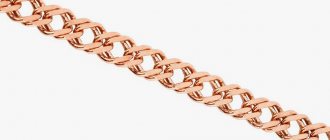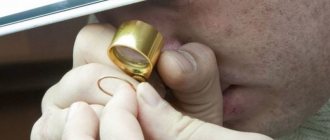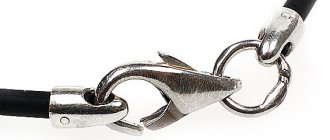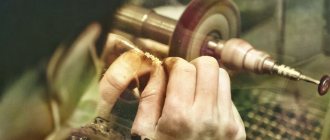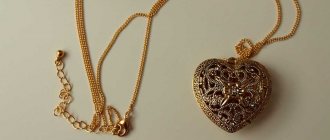The first gold chains appeared in Ancient Greece and the cultures of Mesopotamia. They were symbols of divine origin, wealth and a sign of belonging to the royal family. Luckily for us, jewelers have been able to make gold jewelry much more affordable.
Gold in its pure form is very soft and has a bright yellow color. To give the desired color and make gold more durable, other metals are always added to it.
To give it a reddish tint, copper is added to it, and with brass, metals melt faster than if gold and copper were melted without it. Depending on the amount in which these metals are mixed into gold, we get an alloy of 14 and 18 carat gold. The mixture is melted in crucibles at a temperature of 1010° C.
The boiling alloy is poured into a casting machine with water, which cools the metal to a temperature of 370°C to harden it. The solidified gold is passed through a circular mold, which is shaped into a 2 meter long pole.
The pole, cut in half, is passed through a crimping rolling mill, bringing it into a square shape, so it will be easier to stretch. The pole is then passed through a tandem mill. The rollers of the machine stretch it to approximately the thickness of spaghetti. At the exit, the rollers twist it into a spiral 24 m long. To soften the metal, the spiral is sent to the oven.
The spiral is unrolled and pulled out again, but to the thickness of the wire, passing it through a mill with industrial diamonds. The gold is doused with a liquid lubricant to protect it from overheating. At the exit we get gold in the form of the thinnest wire. The wire is wound onto a reel. Up to 3 km of wire can be wound on one reel. The coils are unwound and placed in the furnace again, the gold will soften even more.
Specialists at the factory are prohibited from wearing jewelry for safety reasons. At the end of the working day, all workers go through a metal detector, which minimizes any theft.
Venetian weaving of gold chains
Venetian weaving of gold chains is made on a different machine (see video). The wire is placed in a special channel, in which mechanical clamps bend it around the shape, connecting it to the previous link.
To prevent sticking in the subsequent manufacturing stage, the gold chains are coated with powder and heated to 815°C.
The machine attaches locks to each end of the chain, and a stamp is placed indicating the purity of the gold (fineness). The chains are soaked in four tanks of chemicals. They clean the gold from any contamination. Gold chains are coated with a thin layer of gold. That's why they shine so well. After quality control, the finished gold chains are sent to the shelves of jewelry stores.
Stages of creating a gold chain
The bulk of gold jewelry is made by machine knitting or stamping. Using the first, thin, almost weightless products are created. Massive thick chains are made by stamping. The process of transforming a shapeless gold mass into a beautiful piece of jewelry takes place in several stages.
- Alloy preparation. Any gold chain is not 100% precious metal. In its pure form, this material is too soft and jewelry made from it will be very short-lived. To improve the performance of products, various impurities are added to gold: copper, brass, etc. The melting point is 1010 degrees.
- The resulting alloy must harden. To do this, it is placed in a casting machine with water for cooling.
- The finished material is processed roundly using a mold. From there the gold comes out in the form of a two-meter pole, which is cut in half.
- To give the workpiece a certain shape, it is rolled through a crimping machine in a rolling mill.
- The next stage is stan-tendem processing. Equipment rollers pull out the workpiece, which at the output is twisted into a spiral 24 m in length.
- Now we need to make gold wire. The spiral is sent to the furnace, straightened and passed through the mill.
- To prevent the products from sticking together during processing, they are sprinkled with a special powder and heated again to 820 degrees.
The result is almost 3 km of thin gold wire. It is wound on a reel and then used to create chains of different weaves.
Fasteners are attached to finished products using a special machine and a sample is stamped. Almost finished jewelry is sequentially immersed in four tanks with chemical solutions to wash away all production contaminants. Finally, they are coated with liquid gold, thereby achieving greater shine.
All jewelry is tested in quality control. Chains with defects are returned for melting, and those that pass the test are sent for further sale.
Blown gold production technology
To make blown gold, metal wire is used and coated with gold. After a series of chemical processes, the wire is removed, forming a void inside the product. This technology allows you to make massive products that are distinguished by originality, weaving, volume and price.
Today, there are several methods for producing blown products:
- Wrapping. This method is primitive; jewelry made using this method is of poor quality, they are heavier than others, and folds of the metal may be visible.
- Cladding. This method is complex, but the quality is much better.
- Window. Complex technology that takes a lot of time, but the demand for such gold is great.
- Hitch. Using this method, you can obtain jewelry that is distinguished by quality, durability and can satisfy the most sophisticated tastes.
Independent News Global InterGold
Tweet
Creating a gold chain is a complex and interesting process. There are modern mechanized technologies that allow you to create spectacular and beautiful jewelry with various types of weaving.
We tell you how gold chains are made.
Creating a blank
In its pure form, yellow precious metal is too soft and is not suitable for making jewelry. To create chains, various alloys of gold with silver, copper and zinc are used. This increases the strength and durability of the product. By changing the proportions of the metal added to the alloy, a certain color and sample of jewelry is obtained.
The table shows the compositions of alloys for producing yellow, white and rose gold.
As a result of melting metals, a precious workpiece is obtained - a gold rod with a diameter of about 10 millimeters.
In the photo: further processing on a special machine involves rolling the rod into wire with a diameter of 1 millimeter, which has high malleability and ductility.
But this gold wire is not thin enough to make chains. Its diameter is reduced to 0.15 millimeters using special machines. At high speed, the gold wire is pulled through narrow diamond nozzles, causing the metal fiber to become much thinner.
Then the thinnest gold thread undergoes heat treatment, which makes it more flexible. Next, the precious thread is cleaned using ultrasound.
Weaving the pattern
“Knitting” of the chain is done by special machines, each of which creates a certain type of weaving. The gold wire is passed through a mechanical device, which weaves a beautiful pattern from its fragments, connecting the finished links together. A professional device is capable of creating a chain of 600 links in 1 minute.
There are many types of chain weaving. The most popular is “anchor” :
Bismarck weaving is the most durable:
“Armor” weaving is in greatest demand among men:
Final stages
After weaving is completed, the product is coated with a special gold-containing powder. The chain is placed in an oven heated to 900 degrees, where the solder powder melts and makes each element monolithic.
Then the gold chain is cut into pieces of the required length and polished with a diamond-coated polishing machine.
The next step in making jewelry is attaching the clasp.
In the photo: next to the clasp, a small gold plate or ring is attached, onto which a metal sample is applied.
The final step in creating a gold chain is to clean the piece in a chemical solution containing rhodium. It adds additional shine and prevents a person from developing allergic reactions to the composition of the gold alloy. The finished gold jewelry is sent to jewelry stores and stores.
Golden automatic burst
If you think that only chains of one weave can come out from under a chain knitting machine, you are deeply mistaken. Modern devices are so technologically advanced that they can be used to make almost any chain, even with the most complex openwork weaving.
The equipment makes it possible to produce links from wire whose thickness does not exceed 0.2 mm. Just imagine what an elegant product can be born from such a golden thread. The weight of some chains is only one gram, so when making them it is very important to observe all the technological details. When purchasing such a thin chain, be sure to ask where it was made. It is desirable that the manufacturer be fairly well-known and have extensive experience in creating chains and bracelets.
What automatic weaving is the most popular? Anchor weaving is known to everyone. Perhaps this is the oldest type of weaving, in which round, oval or rectangular links are connected perpendicular to each other. A single anchor chain serves as an excellent basis for a pendant, but double weaving or large links turn it into an independent decoration.
The chains are very strong - armored, they do not break or twist even when worn carelessly. Men often choose Bismarck weaving chains - reliable and massive. They can be very impressive if decorated with a diamond cut. Women's gold chains of automatic weaving are more refined - these are “Nonna”, “Heart”, “Love”, “Perlina”. By the way, the last weaving was automated not so long ago.
Dozens of possible models make choosing a chain quite a difficult task. It is unlikely that a private jeweler will be able to offer you such variety. There are usually no more than a dozen items in the catalog, and if you want something else, the master may either not take it or not give a guarantee for the finished product.
Weaving chains with your own hands
A product woven using the Viking Knit method is made of soft wire and does not require soldering. When weaving a chain around the neck, the material used is increased.
Before work, you need to prepare a pencil that will serve as a support, thin copper wire, scissors and a ruler. Weaving begins with preparing the base for the chain. Cut about 40 cm of copper thread and wrap it around the ruler, making 6 turns. Remove the resulting loops from the tool and secure them by wrapping them with the short end of the wire. Move the petals in different directions and place them on the blunt side of the pencil, bending them along the support. Start weaving with a new piece of copper thread 80 cm long. Make a loop by threading the wire through one of the warp petals. Then, turning the pencil, insert the upper end of the thread inside the next petal, bringing it out on the left side. In this way, tie loops around the entire base.
The new row begins with the girth of the loop of the previous circle. Then weaving continues in the same way until the working wire runs out. Twist the tip of the new piece of thread with the previous remainder and continue weaving to the required length. Subsequently, this tip will be hidden in the work. Please note that at the end of the work the chain must be stretched. Its length will almost double.
Using the methods discussed above, both men's and women's chains can be woven. By learning to make jewelry, you will gain good experience with metal and learn basic jewelry making skills.
Popular types
Today there are many types of weaving gold chains. Some of them are especially popular and have several subspecies. Anchor weaving is considered universal: suitable for women, children, men. It is not so difficult to perform, but strength is ensured. Suitable for massive and thin chains for a cross, pendant or pendant.
The essence of weaving is to make links of the same size, oval or other shape, perpendicularly connected to each other. The final product resembles a smaller version of a real anchor chain. Subtypes of weaving types:
- Sea anchor - almost no different from the standard decoration, but has a jumper that helps strengthen the links.
- Rollo or Belzer - the links are not oval, but round. They are connected according to the standard principle and are durable.
- Venetian weaving - involves making from square or rectangular links. Products may have several rows.
- Double anchor - usually has two rows of oval-shaped links, tightly connected to each other.
- Double rollo or Garibaldi - similar to the anchor style, but the links are connected in twos.
- Cord weaving helps to obtain twisted products at the output, since it is characterized by the connection of several links at once.
Most often, the anchor type is used to make children's and women's jewelry. Massive chains for men are produced less frequently.
Subspecies Bismarck
In the last century, this subspecies was considered truly female. Handmade jewelry was an integral part of a lady's image; it was light in weight and long in length. Several decades ago, weaving began to be used in the production of men's chains.
Bismarck can be classified as the most durable type of link connection. The essence of the method is the fancy fastening of links consisting of several thin rings. In the 90s of the last century, every businessman preferred just such chains weighing at least 150 grams. The species has several subspecies:
- The semi-volume option means that the thickness of the link is slightly greater than the width of the entire chain.
- The triple subtype assumes the presence of three rings in each link, whereas in the classic there are only two.
- The flat type is a product similar to the classic Bismarck. The width of the chain is almost twice the thickness of the link.
- The Arabic version resembles letters and is popular due to its unusual appearance.
- Royal Bismarck is voluminous, the chains are round on all sides, the type of weaving is quite ornate and sophisticated. Suitable for men and women.
Such products, characterized by increased strength, are among the most desirable among all varieties.
Cardinal and Foxtail
Cardinal, Python, American, Pharaoh - names of the same type of weaving of gold chains. It is an elegant yet extremely durable weave that is popular among men and women. Thanks to its reliable design, you can wear it all the time.
This type of weaving can be used to make massive chains or fine jewelry for women. The average weight of a piece of jewelry starts at 15 grams, but the weight does not make it bulky or heavy.
Fox tail is a variant of the royal or Byzantine weave, distinguished by its grace, strength and durability. Rarely used to make women's jewelry, but it is especially popular among men. Machine production is not used for this type, since the chain can only be made by hand.
Armor weaving
It is considered one of the most durable, reminiscent of the anchor type. The difference is that the links are connected in the same plane, and not perpendicularly. Suitable for men and women, for massive and elegant jewelry. Has several subspecies:
- Nonna is almost no different from the classic version. A special diamond coating is applied to the front edges of the links, allowing the product to play with a variety of highlights in open sunlight.
- Armored - parallel, the technique resembles the classic look, but at the same time two links located next to each other are connected. This weave gives the product grace, makes it strong and durable.
- Love is a unique subspecies suitable for women. In production, links are used that resemble hearts in appearance. Usually the chains are light, hollow, airy, and the cost is affordable.
- Snail - distinguished by the shape of the links, reminiscent of a snail. The type of fastening is unchanged, but does not interfere with the creation of a durable, reliable, elegant structure.
Either option would be a good choice for both men and women. There are cases when several types are combined in one product, making it original and unique.
Rollo and Cartier
Rollo weave resembles the anchor type, but the links have a clear, rounded shape. Suitable for adults and children, it is highly durable, but the manufacturing process is simple. The links are connected perpendicularly. The decoration will complement the image, can be used as a chain for a large pendant and will not distract attention from it.
Cartier belongs to unusual types and is suitable for those who prefer to be the center of attention. The chains are quite durable, suitable as an additional element to the image. The essence of weaving is to connect links of different shapes and sizes. The classic version involves 3 round, small links for each large oval-shaped element.
With a medium length, the decoration looks elegant; when combined with a pendant, it is better to choose a longer chain. Short ones are suitable for children. Whatever option a person chooses, the accessory will become an important detail of any image.
Unusual varieties
There are several weaves that are distinguished by their grace and strength. The spikelet is characterized by increased reliability and complexity of manufacture, a bit reminiscent of a Fox's tail. But in the latter the links are directed in different directions.
Externally, the chain really resembles a wheat ear. It is distinguished not only by its beauty, but also by the absence of the need to constantly unravel. The spikelet hardly gets tangled, which is considered an undoubted advantage.
Rose or Chamomile is considered a feminine type because the links resemble a flower. They are connected in a unique way, making the decoration durable. Typically, products are lightweight and can be worn alone or with additional details.
Triplet or plait is a strong weave that requires the concentration of the master when performing. It looks like a tourniquet and is suitable for men and women. The former prefer massive gold jewelry, the latter prefer elegant and thin ones, combined with pendants and pendants.
